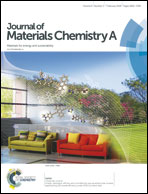Nitrogen-rich salts based on the combination of 1,2,4-triazole and 1,2,3-triazole rings: a facile strategy for fine tuning energetic properties†
Abstract
The synthesis of four neutral 4-nitro-5-(1,2,4-triazol-3-yl)-2H-1,2,3-triazole compounds in combination with different energetic moieties like amino, nitrimino, nitro, and azo groups is presented. Furthermore, a novel family of energetic salts based on the 4-nitro-5-(5-R-1,2,4-triazol-3-yl)-2H-1,2,3-triazole (2: R = nitrimino; 3: R = nitro) monoanion and dianion were controllably synthesized. All new compounds were fully characterized by IR and multinuclear NMR spectroscopy, elemental analysis and DSC measurements. The molecular structures of 2, 3, 8 and 17 were determined by single-crystal X-ray diffraction. In addition, the heats of formation and detonation performance of all the energetic compounds were calculated using Gaussian 09 and EXPLO5 v6.01 programs, respectively. Both experimental and theoretical evaluations show promising properties for these energetic compounds, such as high density, positive heats of formation, high thermal stabilities, good sensitivities and excellent detonation performances. Among them, 6, 7, 14 to 16, 24 and 25 exhibit favorable overall properties as energetic materials.



 Please wait while we load your content...
Please wait while we load your content...